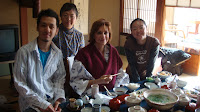










Pictures: (1-3) Sign at the second traditional hotel where we stayed; (4-6) View from/in the room; (7,8) The Japanese "Denny's"; (9,10) Saturday morning wake-up; (11) Our hosts bid us good-bye.
April 2nd (cont.): Before leaving to visit the Imperial Villa at Katsura on April 2nd, Fumi-san, Mari (who joined us that morning), Kentaro, and I had our bags dropped off at the second traditional hotel in Kyoto we would be spending the night at, that evening. The hotel's business card was all in Japanese, so I don't know the name. But the trademark for the hotel was an ancient Japanese lady's mask, pictured on their card. Mari patiently tried to explain the history of it to me, but I didn't get it, so I scanned a copy of their business card and posted it, the second image above.
Like our last hotel, this one also had the sliding shoji screens, traditional robe, and a futon to sleep on at night. However, instead of a scenic zen garden outside our window there was a river, along which people walked their dogs or jogged, on a narrow strip between the river itself and a tiny canal that ran alongside it. Later that evening, after the day's activities, Mari took her guitar (which she laughingly called her "boyfriend" as she lugged it around on her back all day) and gave a little concert for passers-by. Mari is a musician with a beautiful voice, and I am sorry to say that I conked out before she went to sing. So sadly, I missed it.
Anyway, after dropping our things off at the unnamed hotel, we went to see the Imperial Palace. Here, the tour was completely in Japanese and there was no handy translator box for foreigners like me, so my research was confined to reading the brochure.
I learned that Kyoto was the capital of Japan for over 1,000 years, having been moved from Nara in 784. The Imperial Palace served as a political and cultural center, and from the outside (we weren't allowed to traipse through the inside), it was very beautiful, indeed. Although a bit more ostentatious than Katsura and certainly larger, it contained similar strolling gardens which were spectacular. I don't believe anyone can top the Japanese for knowing how to create the perfect garden scene.
Here's the odd thing: (quoting the brochure) "The Imperial Palace, called the dairi, was situated in a fixed place...which was rebuilt every time it was destroyed by fire. While the Imperial Palace was being rebuilt, it was customary for the Emperor to move temporarily to the residences of members of the aristocracy." This happened so often, it seems, that the temporary residences came to be known as the de facto Imperial Palace, or satodairi. According to the brochure, the dairi was destroyed time after time by fire. It eventually fell into ruin, never to be rebuilt again.
In fact, the showy buildings that we saw were actually the homes of the aristocrats where the Emperor lived while the original Palace was being rebuilt, tme and again. What in the world, I wondered aloud, could have caused so many fires in the original Palace?? My guess was that outside enemies attacked it as Japan's center of power. Kentaro thought it was warring factions within Japan itself. However, it turns out we were both wrong. We were thinking too big. Kentaro asked the guide what was the cause of these many fires, and do you know what it turned out to be?
Bugs.
Yes, that's right. Apparently, the groundskeepers were trying to kill the pesky varmints, and kept burning the place down. For some reason (I was a bit under the weather at this point and may have been delirious), I found this hilarious. Talk about using a cannon to kill a fly! One would think that, whatever the bug problem was, it couldn't have warranted burning down these massively expensive edifices. Or, that they would have figured out after the first few disasters that maybe they should try another way. But, there you are. Human blunder flying in the face of art. Luckily, my hosts have a sense of humor, and joined in my merriment, although probably they were just laughing because I was chortling uncontrollably and it was contagious. Still, it does make one wonder about the competence of those groundskeepers.
Anyway, I managed to keep my mirth mostly under control after that, as I went on a quest to find a trash can to throw out my kleenex. And while visiting the Palace souvenir shop in my search, I did find a very cute kitty cat charm for my daughter, which was modeled after the symbol for Princess Aiko, the granddaughter of the current Emperor.
A sad note about trash cans in Japan: At first, when I noticed that there was not a trash can to be found anywhere (even in the lobbies of large hotels), I concluded that the Japanese must just be extremely neat. To be sure, it's rare to see any litter on the streets or anywhere else in Japan. At least not that I saw. But since I had a bit of a cold, I was always looking for a place to throw out my kleenex, unsuccessfully. So I asked what the deal was with no trash cans, and Kentaro told me that about 10 years ago, there was a disaster in a train station where someone put poison gas in a trash can, killing 3000 people. As a result, no trash cans. Anywhere. Sad to think that such a heinous act still affects innocent people after all that time.
And strange to think that in America, land of the ubiquitous trash can, there is so much litter everywhere.
But, I digress. We finished our visit to the Imperial Palace, and I was feeling worse and worse. The weather was cold, intermittently cloudy mixed with rain. To be considerate to my cappuccino addiction my hosts took me to a local Starbucks, then we ate in a restaurant that Ken said was "like a Denny's"; except that you checked your shoes at the door, wore slippers, and were each served on charming trays full of tiny portions of different foods (mostly vegetables and low calorie), along with a pot of tea. (See picture 7 above.) And of course, the wonderful modern Japanese toilets.
After that, we returned to our hotel, where I passed out on a futon after reassuring my hosts that I was "fine." I slept several few hours and was awakened by their return. They had brought me some wonderful fresh strawberries and edamame (aka baby soybeans still in the pod). It was the perfect meal for my challenged system, and I ate it with pleasure.
Kentaro also gave me two cups of dry soup (add water). As I always do, I checked for the "cals" (calories) on the package, and saw "170 kcals."
I'd seen the "kcals" notation on packages before on my trip, since I obsessively check the caloric content of every packaged food item I buy. I just assumed it was a different way of saying the same thing we say in America for calories.
So I asked Ken, what's up with the kcals? What does that mean? Is it the same as "calories"? Ken (who is slim as a reed and I am sure never thinks about calories), studied the package, and said, "Well, K stands for 1000. So maybe it means one thousand." This was too much for my weakened system to ignore (apparently being sick lowers my threshold for humor) and I started laughing uproariously, saying "Do you mean this tiny cup of soup is 170,000 calories??? That would mean I'd be fat as a house if I ate it! In fact, you're the only one who could handle that kind of overload!"
From there I collapsed into hysterical laughter, which Kentaro and the fam joined in. After all, laughter is the best medicine isn't it, no matter what the source? I think so. Kentaro wanted me to go to the clinic in the morning, but after the simple yet perfect repast (I passed on the soup), a good night's sleep, and the apparently enormous healing qualities of a good guffaw, I awoke the next morning feeling much better. (See the last two pictures, above.) And for the next week I would crack myself up, whenever I thought of that soup. (Okay, I still do.)
I've included some pictures below of the Imperial Palace, or at least of the back-up Imperial Palace. And please, no laughing. Bugs are a serious matter.
Pictures: A sampling of the Imperial Palace. Shots 2 and 3 depict two of three waiting rooms, where visiting dignitaries were escorted while waiting to see the Emperor. Which room they were sent to depended upon their importance. I think the White Tiger room was for the most important. Note also the beautiful cherry blossom tree in full bloom, picture 4.









No comments:
Post a Comment